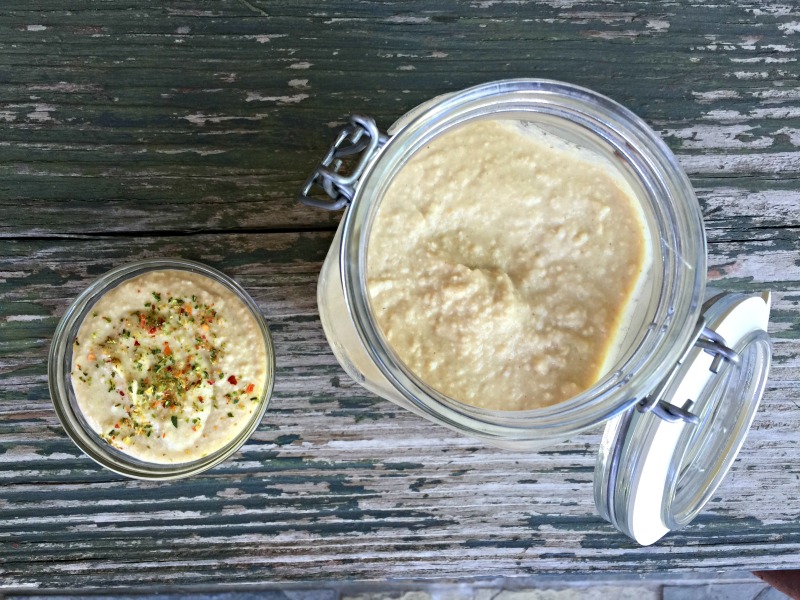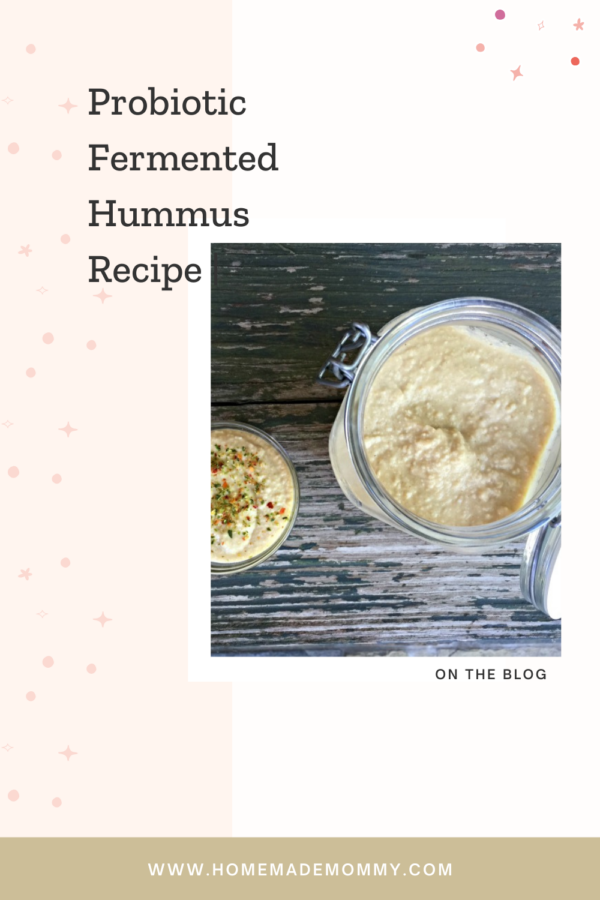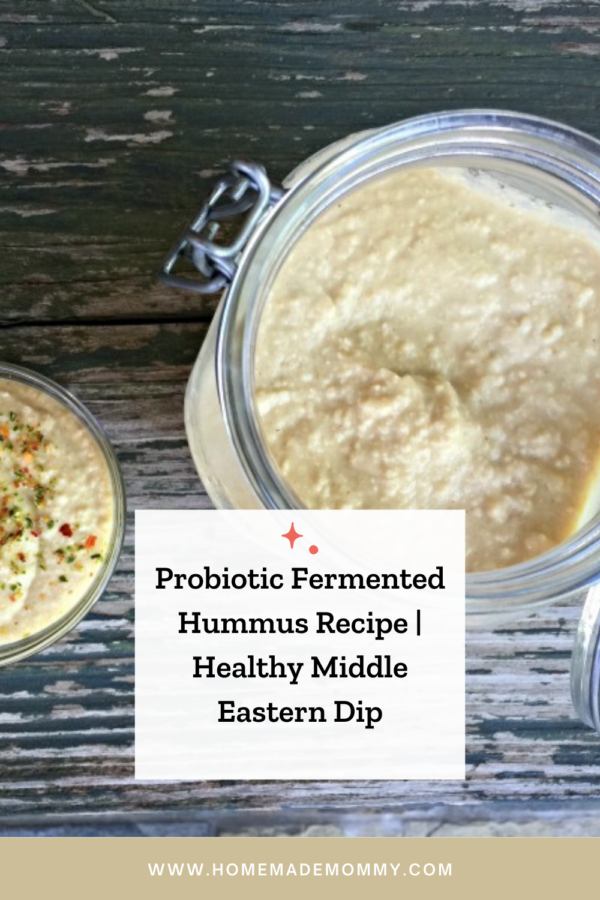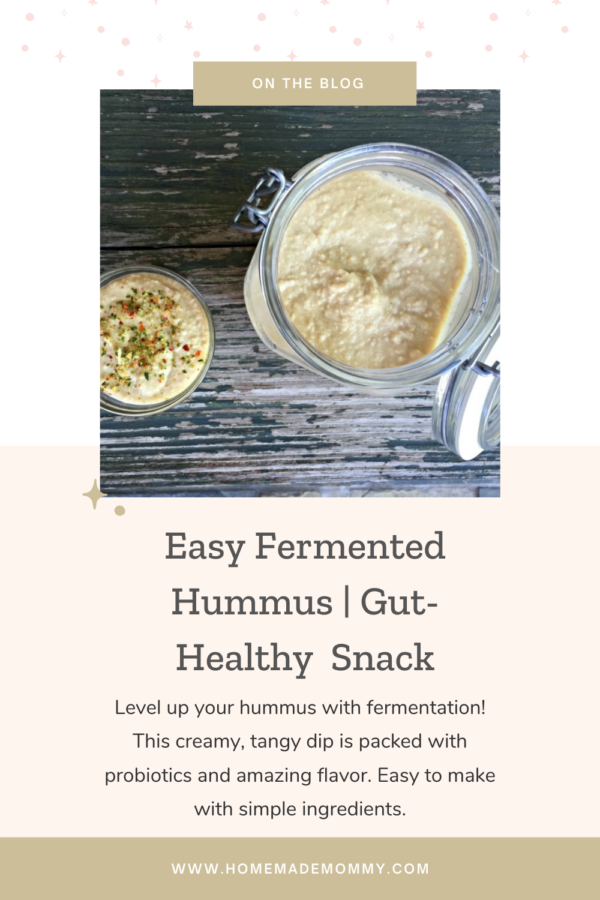Probiotic Fermented Hummus

As someone obsessed with fermented foods, I’m always looking for new things to ferment. My kitchen counter regularly hosts bubbling jars of sauerkraut, kimchi, and garlic. So I got to thinking – why not ferment hummus?
The idea came when I needed to pack lunches for my daughter’s new school, which required non-meat options. While brainstorming ideas, I realized I could combine my love of fermentation with a classic hummus recipe. The result? A tangy, probiotic-rich dip that my whole family devoured.
The fermentation process transforms regular hummus into something special – adding complex flavors and beneficial bacteria. Plus, it lasts longer in the fridge than traditional hummus, which is always a win. My husband, who usually reaches for the spicy salami as a snack, found himself grabbing pita chips and this fermented hummus instead.

Benefits of Fermented Hummus: A Nutritional Powerhouse
- Enhanced Digestibility
- Fermentation breaks down hard-to-digest compounds in chickpeas
- Reduces bloating and gas commonly associated with legumes
- Makes nutrients more bioavailable
- Probiotic Benefits
- Introduces beneficial bacteria to your gut microbiome
- Supports immune system function
- Aids in overall digestive health
- Extended Shelf Life
- Natural preservation through fermentation
- Maintains freshness longer than traditional hummus
- Develops deeper flavor over time
- Increased Nutrient Profile
- Higher levels of B vitamins
- Enhanced protein accessibility
- Improved mineral absorption
Fermented Hummus Recipe
Probiotic Fermented Hummus
Ingredients
- 4 cups cooked chickpeas
- 2 tablespoons ghee
- 1/4 cup cold pressed extra-virgin olive oil
- 3 tablespoons tahini
- 3 cloves fermented garlic
- 1/4 cup fresh lemon juice plus 1 tablespoon
- 2 teaspoons ground cumin
- 1/4 teaspoon cayenne pepper
- 1.5 teaspoons salt
- 1/4 cup chickpea cooking liquid
- 1/4 cup liquid whey
Instructions
- Combine all ingredients in a food processor and puree until smooth.
- Transfer to a clean glass fermentation jar.
- Cover loosely and let ferment at room temperature for 7-10 hours.
- Refrigerate and enjoy! Can be eaten immediately or after fermentation.
Notes
Fermentation: Best at room temperature (65-75°F)
Tips: Use homemade whey for best results
Substitutions: Can use regular garlic if fermented garlic unavailable
Serving suggestions: Perfect with vegetables, crackers, or as a spread
Nutrition
Essential Tips & Techniques for Perfect Fermented Hummus
Container Selection
- Choose wide-mouth glass jars – I love these jars for fermenting
- Ensure containers are thoroughly cleaned
- Leave 1-inch headspace for expansion
Quality Indicators
- Look for small bubbles forming
- Expect a slightly sour aroma
- Watch for a subtle rise in volume
Common Mistakes to Avoid
- Using metal containers (can react with fermentation)
- Over-processing chickpeas initially
- Adding too much whey at the start

Creative Variations to Try
Basic Additions:
- Roasted Garlic & Herbs
- Smoky Paprika & Cumin
- Caramelized Onion
- Fresh Herb Medley
Seasonal Twists:
- Summer: Roasted Red Pepper & Basil
- Fall: Pumpkin & Sage
- Winter: Roasted Beet & Dill
- Spring: Fresh Pea & Mint
Kid-Friendly Versions:
- Mild Carrot & Sweet Potato
- Apple & Cinnamon (slightly sweet)
- Golden Turmeric & Ginger
- Cucumber & Mint
Serving Suggestions & Meal Ideas
School Lunch Box Combinations:
- Veggie stick platter with fermented hummus
- Whole grain pita triangles and hummus
- Hummus sandwich with cucumber and sprouts
- Hummus-stuffed mini bell peppers
Party Presentations:
- Mediterranean mezze platter
- Rainbow vegetable crudité board
- Layered hummus dip
- Individual hummus cups with toppings
Creative Uses:
- Spread for wraps and sandwiches
- Base for grain bowls
- Salad dressing (thinned with water)
- Pasta sauce alternative
Frequently Asked Questions
How long does fermented hummus last?
- 2-3 weeks in refrigeration
- Best flavor develops after 3-5 days
- Watch for any off odors or mold
How do I know it’s properly fermented?
- Slightly tangy aroma
- Small bubbles present
- Texture becomes slightly fluffier
- pH should be around 4.0-4.5
Can I use different legumes?
- Yes! Try:
- White beans for a milder flavor
- Lentils for a earthier taste
- Split peas for a sweeter note
- Black beans for a robust version
Why isn’t my hummus fermenting?
- Check room temperature
- Ensure whey is active
- Verify salt ratio
- Consider fresher ingredients
What if my hummus is too thick/thin?
- Adjust with chickpea cooking liquid
- Add olive oil for richness
- Use food processor to re-blend
- Let it sit to thicken naturally
Can I speed up fermentation?
- Add more whey (up to 1/3 cup)
- Increase room temperature slightly
- Use fresher chickpeas
- Add a pinch of mineral-rich salt


Is it supposed to be a 1/4 cup liquid whey?